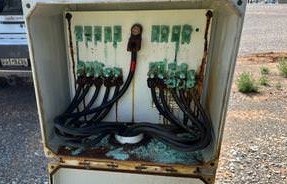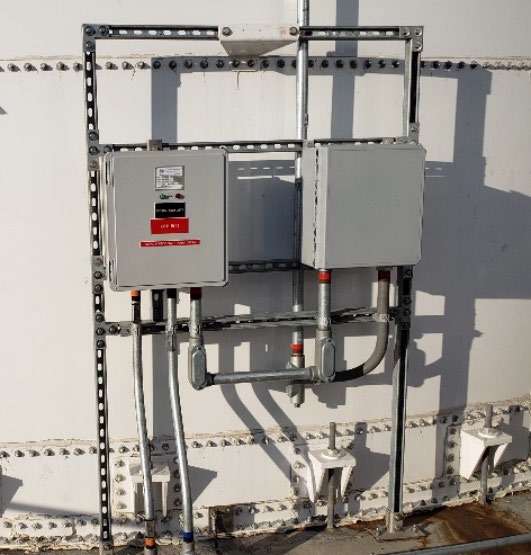EXPERT TIP #28: PREVENTING CORROSION OF CATHODIC PROTECTION EQUIPMENT
The Use of Cathodic Protection
Cathodic protection prevents corrosion of pipelines, storage tanks, and other critical buried or submerged infrastructure assets that support our daily lives. When used effectively, cathodic protection (CP) and coatings are the best methods for preventing subsurface corrosion.
When CP is employed, some steps should be taken to prevent the corrosion of the above-ground CP equipment used to protect the subsurface infrastructure. If the degradation of the equipment is not prevented, the CP system may not last as it was designed.
A deep anode well is utilized in many impressed current cathodic protection (ICCP) systems. A deep anode well system consists of a vertically drilled borehole, typically 8 to 12 inches in diameter, and the depth can vary from 50 feet to over 500 feet. The anodes are lowered into the hole to the specified depth and surrounded or “backfilled” with calcined petroleum coke breeze (carbon) to provide good electrical contact with the soil.
A vent pipe is installed into the deep anode well during the loading of the anodes and coke breeze. A vent pipe is typically made of 2” SCH 80 PVC pipe, vented with holes or slots. At the surface, the PVC vent is finished in the shape of a “U” to keep rainwater from entering the vent.
When anodes discharge DC current, oxygen is generated. This oxygen combines with chlorides in the soil or water and is then converted to chlorine gas. In some cases, the gas will diffuse into the surrounding soil, but where the anodes are in dense soil or mud, the gas does not diffuse into the earth. As the gas is not electrically conductive, and once enough gas builds up around the anodes, the anode system can no longer generate DC current, which is commonly known as “gas blockage.” To prevent this problem, a vent pipe is routinely installed to route the chlorine gas to the surface of the well.
Corrosion Caused by Vented Gas
A mistake often made is installing the vent pipe near or upwind of the above-ground CP equipment, such as a rectifier, junction box and remote monitor. The escaping chlorine gas, which is corrosive, can then permeate this equipment, causing damage to rectifier components, junction box connections, bare cable and steel enclosures. Therefore, it is best to provide some distance between the vent pipe and the CP equipment to prevent the potential for chlorine attack.
Sealing of Conduits
When anode cables from a deep well anode system are routed into an anode junction box, sealing the electrical conduit that carries the anode cables into the junction box is a good practice. The reason is that there is a potential for water or chlorine egress into the junction box, causing corrosion of the components, such as the bare cable ends, the cable connectors, buss bar and shunts. Sealing the conduit with a commercially available sealing compound or foam, specially made for this purpose, helps prevent water or gas intrusion and premature failure of the electrical components.
Electrical Cabinets
Rectifiers, junction boxes, pull boxes and other electrical equipment often utilize metallic enclosures. If not properly designed for the application, these enclosures may deteriorate prematurely, which is unsightly at best. Choosing the best material for the application is key and, if done correctly, will keep the effects of atmospheric corrosion at bay.
The most common rectifier enclosure material is hot-dipped galvanized steel, which is very sturdy and reasonably good at resisting corrosion for many years. However, if the cabinet is in a humid region or near the ocean, this may cause the cabinet to deteriorate more rapidly. If this is the case, another material choice, such as aluminum, which is also much lighter, or stainless steel, may be prudent. Cabinet coatings can also help prevent atmospheric corrosion of rectifier cabinets. Powder coating, anodizing or other specialty coatings, depending on the cabinet material, can also help to prevent corrosion.
There are a variety of cabinet choices for anode junction boxes. This includes galvanized steel, powder-coated steel, aluminum, stainless steel and non-metallic choices. Proper selection of the appropriate cabinet materials is important in this case, too.
Other Considerations
Other material choices are required for other electrical equipment used for CP system installation. Electrical conduit is available in PVC, galvanized steel, aluminum and PVC-coated steel. The best choice depends on the application, the environment and code requirements, if any. There are also decisions to be made for proper cabling, cabinet support structures, electrical fittings and more. Choosing the proper material for the application and system requirements is important and should be considered carefully for an effective and lasting CP system design.






